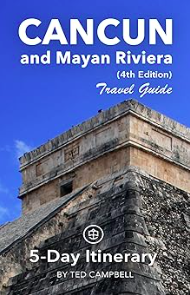How to Cut a Mango and Get Deported from Spain
Note: The first half of this story, How to Cut a Mango, first appeared in my column at Expat Focus. Please click here for the second part, Get Deported From Spain And Go To Mexico Instead
Thanks for reading.
I spent years cutting the mango in bizarre ways until I met Sam. We sat in plastic lawn chairs on the sunny balcony of a hotel in Tulum, Mexico, drinking coffee and eating mangoes.
I gave a clumsy yank on the peel and he burst out laughing.
“Man, what are you doing?”
“I don’t know, eating this mango.”
“Like that?”
I shrugged. At that time I was in a mango-peeling phase of making a few short slices at the tip and then peeling them down, as if for a stubborn banana.
This method was terrible. I did it on a bus once and had fibers in my teeth all day. You experience a wide range of emotion with mango fibers in your teeth – annoyance, frustration, embarrassment, reticence. You long for the roll of dental floss in your toiletry bag.
The mango is the sweet but stubborn blaze-orange fruit of the tropics. They range from fitting snugly in the palm of your hand to the size of a child’s Nerf football. Some are sweeter, some are more yellow, but they all have three big obstacles to clean eating: a tough skin, a long hard stone, and flesh that is better to chew than to bite into because it’s full of fibers.
Originally brought from the Philippines by the Spanish, the mango has become one of Mexico’s favorite fruits. It can be found year round, but is best in spring and fall. The mango is made into candies, drinks, and sauces, and plays a prominent role in the big fruit cocktails you can buy on the street for cheap.
All around Mexico guys ride around on little three wheel bicycles called carritos. From these they sell potato chips (which are invariably covered in lime juice and hot sauce), small cups of jelly, or my favorite, fruit cocktails. For between one and two dollars you can get a big plastic cup full of watermelon, melon, papaya, jicama (aka Mexican turnip), cucumber, orange slices, shredded carrots, banana, strawberries, and mango. Mexicans dump chili powder all over it, but I prefer just a squeeze of lime.
As wildly convenient as these fruit cocktails are, it’s even easier to get a big bag of fruit at the market or fruit shop. But look out for trucks full of fruit on the side of the road. When the fruit gets ripe, like at the end of spring (when I’m writing this story), you can get the freshest and cheapest fruit straight from the pickup truck.
However, buying the fruit is often easier than peeling it. Use guesswork at your peril – fibers in your teeth, sticky fingers and wasted sections await those who peel improperly.
So Sam set me straight for the mango. Slice lengthwise along each side of the stone. Then you have two nice halves to spoon fruit out of.
Next pull the little strips of remaining peel off the stone, from the stem-hole down (Sam insisted on this), and chew off the remaining fruit. I still got a few stray fibers in my teeth, but not Sam. And we went through many mangos during our three days in Tulum.
Tulum, on the Mayan Riviera near the southeast corner of the country, refers to three places on the Caribbean, all a few km apart: Mayan ruins, a beach, and a small highway town. The town seems like little more than a tourist stopover until after dark, when locals hang around the basketball courts eating street food and neon bars serve fish, beer and loud party music.
Most famous for Cancun, the Mayan Riviera is Mexico’s tourist fantasyland, a jungle coastline of white-sand beaches and cenotes, freshwater sinkholes and caves found throughout the flat limestone sponge of the Yucatan.
South of Tulum is the Sian Ka’an Biosphere, a massive nature reserve. North of Tulum is a brave new world of ambitious development, a stretch of resorts and aquatic parks serving up a sweaty dose of convenience, beauty, gaudiness and luxury. Pockets (and expectations) run deep.
This is the part of Mexico most frequented by tourists. You can have a great time in your all-inclusive resort in Cancun, but if you decide to venture out, I recommend the Mayan ruins of Tulum and a bag of fresh mangos from the beat up fruit truck on the side of the road.
Posted on July 17, 2013, in Uncategorized. Bookmark the permalink. 2 Comments.





Thanks man, good to hear from you!
LikeLike
haha i’ve spent years butchering mangos…usually just give up and eat them over the sink ripping them apart with hands and teeth.
one or the many great things about mexico and central america is the absolute menagerie of fruits for sale virtually everywhere for pennies on the peso. i remember when mango season arrived in Xela…awesome!
You can get almost everything in NYC but it’s never right. The supermarket by my place in Brooklyn has Zapote at $3.49 lb and it takes about 3 weeks to ripen.
also, glad to see you’re still alive and well in beautiful Mexico!
LikeLike